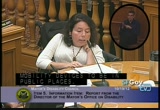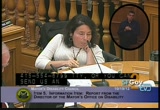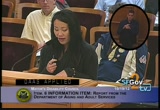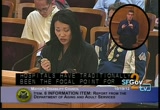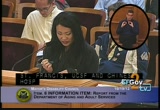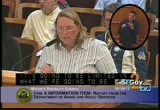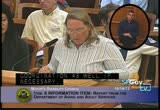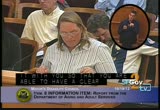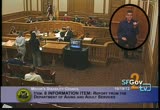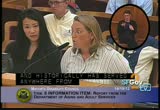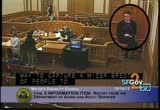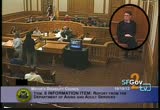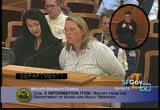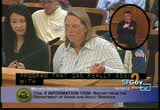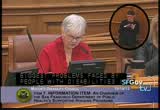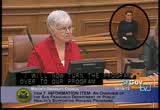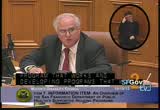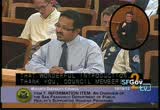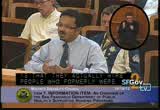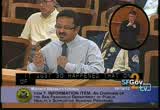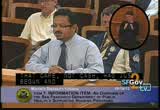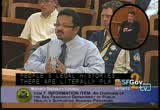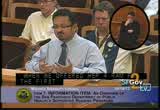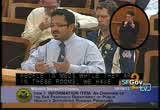tv [untitled] October 30, 2012 1:30am-2:00am PDT
1:30 am
complaints cover both the private and public arena. as a result, our office is working on an assistive mobility device policy which will be updated on our web site, put on our web site, and sent to our ada support leaders so at least within our city facilities and contractors we can actually begin to address that issue. (inaudible) if you do experience these types of barriers please let our office know, we'd like to hear your story, we'd like to hear of the situation. you can reach us at 415-554-6789 voice, 415-554-6799 tty, or you can send us an email at
1:31 am
mod.sfgov.gov. thank you so much and we'll hear from you. >> thank you. moving on to the next item, no. 6, report from the department ofaging and adult services, the san francisco transitional care program, tcp, presentation by daas director of care transitions operations carri wong and tcp program manager dane that leavitt. >> my name is carrie wong, i work with the department of aging and adult services and i have with me dana leavitt, she's the program manager at the san francisco transitional care program. i will start off with just a little bit of the background of how we got to where we're at, then dana is going to go into the program details. daas applied for the community-based transition care
1:32 am
program, tcp program, currently 1 out of 47 participating nationwide. california has 3 of the participating cities, which includes marin county and san francisco. the tcp, which was created by section 3026 of the affordable care act tests for models for improving transitional care setings from hospitals to other setings and reducing readmissions for high risk medicare beneficiaries. care transition occurs when a patient moves from one health care provider to another setting. nearly 1 out of 5 medicare patients discharged from the hospital, which is approximately 2.6 million seniors, is readmitted within 30 days and costs over 26 billion every year. while hospitals have traditionally been the focal point for efforts it reduce readmissions
1:33 am
it is clear there is a continuum of care that impact readmission. by encouraging xhuepts to come and work together, we can improve quality, reduce costs and improve the patient's experience. daas is working with the san francisco transitional care program to forward these goals and maximize independence of seniors and persons with disabilities living in the community to reduce readmissions and of course ultimately reducing institutionalization. the san francisco care program, transitional care program, has been in operation since 2000. it collaborates now with 8 hospitals and 8 community-based organizations. the hospitals that are included in this are the california pacific medical center which includes the 3 campuses, the pacific, st. luke's and daly's, st. francis, ucsf and chinese hospital. the community-based organizations include of course the san francisco senior
1:34 am
center, which is also part of ncphs, the institute on aging, catholic charities, self-help for the elderly, curry senior center, kimochi vernal heights senior care center. i'm going to turn it over to dana to explain about the program. >> so the san francisco transitional care program is a 4 to 6 week program that's going to be incorporating the coaching model of care. and in that they are going to be integrating self-care skills for the patients and by doing that we're going to utilize skill transfer, role modeling, role playing, with the clients to try to improve their skills in these areas. in addition we will also be doing care coordination but it's going to be limited in what we're going to be providing for the individual.
1:35 am
historically, as carrie had mentioned, the transitional care program here in san francisco has been in existence since 2000. the significant change to the program is adding the coaching model. historically we have provided the 4 to 6 week program but it's really been intensive case management programming and what we have realized through both research and also when we did our root cause analysis of how the program was going is that we really felt like if we came from the coaching perspective and were able it reach and try to help people develop skills so that they can help themselves beyond the 4 to 6 week intervention, that we would be a little bit ahead of the game. so what we have done is we've made the decision that in san francisco we would really benefit from both the coaching model and in addition to providing some care coordination as well if necessary.
1:36 am
so once again so where we're coming from more the doer case management model. we're changing that and the philosophy now is letting an individual learn to help themselves. and having more success for that individual in the future. the areas of focus for the program are going to be working with the individual to set their own recovery goals. the goals that would be able to be accomplished in the 4 to 6 week period of time, securing and preparing one's self for the first doctor's appointment, understanding one's health issues and the role of medications, securing -- recognizing symptoms and having a plan of action; developing or having the opportunity to develop a personal health record which is a way to kind of organize and kind of carry it with you so that you are able to have a clear understanding of medical issues
1:37 am
and medications, and establishing necessary services with an emphasis on the areas of nutrition, transportation, home care and medications. as carrie has mentioned this program historically has been an organization that is a network of community-based organizations. and as a result we have been very successful in meeting the cultural and language capacities of san francisco. currently we have transition specialists in these 9 agencies in the language capacity is japanese, vietnamese, chinese, which is both mandarin and cantonese, tagalog and spanish. council members, any questions? >> joanna >> thank you very much for your presentation. how would
1:38 am
people be able to participate in that program? do they get assigned by their doctor, do they ask and advocate for it? >> i think it's going to be a little bit of both. historically the referrals come directly from the hospital so whether that's going to be a social worker, a nurse case manager, ideally the way the program is moving forward we're trying to did a lot of community outreach so everybody knows about the program and once they went into the hospital if it was not something that was brought to their attention they would already know about it and could ask for it. but the referral comes directly from the hospital to our agency. >> and you have started this program already, correct? >> this program has been in existence since 2000. we are, like i said, making changes to the program to include the coaching model. but it has been in existence since 2000 and historically has served anywhere from 200 to 400 clients a year. and we're
1:39 am
hoping to exponentially move that program forward to many, many more people in san francisco. and that's part of us getting the contract with cms, is to help assist with that. >> so basically we're serving a larger bredth of population we haven't reached out to before. traditionally it's been people with high psychosocial needs and a lot of complex things, but now it's expanding more with a lot of different diagnosis because the goal at the end of the day is to reduce readmissions. we're approaching not just seniors but persons with disabilities at any age. when you leave the hospital there's a lot of medications, you are a little confused when you are at the hospital, you are heavily sedated or what not. it's a way to capture a wider bredth of people to secure, make sure.
1:40 am
>> we can kind of look at what program is more about. i mean right after. >> yeah, we've --. >> there are some brochures. >> we have sent electronic copies of the brochure to council members, they are here today in print and braille. is that available online for people to see? >> there's going to be -- yes, it's going to be. >> thank you. >> shortly. we're actually in the really smack dab in the middle of our own transition as a program itself, so we are still serving folks but the coaching model is coming on board probably this month or next. >> thank you.
1:41 am
>> hi, i wanted to thank miss carrie wong and miss dana leavitt for coming out today. it's really interesting about how you mentioned self-care skills for patients from hospital to the department of aging and adult service. it made me think for a moment about the need for self-care skills for persons with disabilities. there's been a recent article about the age groups of the 22-year-olds to approximately 50-year-olds. there is definitely a need there. my question today is do you also accept youth volunteers or youth interns for your department? >> our agency has had interns. usually they are social work
1:42 am
interns. we're based out of the san francisco senior center so we're always looking for volunteers. there's a lot of opportunity, i think, but in regards to the transitional care, usually they are social work staff that are involved in that. >> okay, thank you. >> sarah? >> hi, thank you, i'm just curious what the individuals that are coming out of the hospitals, would they meet the level of care needs to qualify for the in home operations waiver and are you guys making the referral to medical for that or is that traditionally done by the hospital? >> i don't know if i know exactly --. >> it's the home and community-based waiver program which would allow them access to case management, habilitation on-going through that. >> i am aware -- yeah, it's not at this level that we would make that kind of referral. i
1:43 am
think as i understand it comes from the hospital or someone has to make a specific referral there and i know with daas we have our own in-house person that does that, but it's not necessarily a direct --. >> yeah, it's targeted case management that assists with those referrals. >> which is at the hospital level. that's my understanding, what you're talking about. we do a lot of referrals for just the kind of the focus areas that we were talking about, so transportation home care, ihhs, trying to hook them up with low cost care givers if they have just a little bit too much money, really trying to access all the resources in the community to try to assist their situation. we're also, have a small portion of money that's been allocated to our program that can really assist with any particular items. we have actually bought blood
1:44 am
pressure machines for people, we have bought actual beds because they have nothing to sleep on, all that kind of stuff the program has been involved and the program will continue to have. so those are the kind of services we provide for folks. the other thing i did not mention is the program is really, the way it's set up, we do the hospital first, then we do a home visit then going through the 4 to 6 weeks, based on what the client need is, we will either do home visits or we will do phone calls. >> so do you work with the collaborative --. >> that's where that pot of money comes from. >> any more questions? i want to thank carrie and dana very much for your presentation. i know speak being as a senior with disability i would need training and i want to keep my independence as long as possible. thank you for your work. >> thank you very much.
1:45 am
>> income item is no. 7, an overview of the san francisco department of public health's supportive housing programs, presented by marc trotz, director of housing and urban health, and dr. rag parekh, clinical director of hot, homeless outreach team. today we're happy to be continuing on on-going series on meetings on supportive housing opportunities in the city of san francisco. as many of us here know, one of the biggest problems faced by people with disabilities is the lack of adequate affordable and
1:46 am
accessible housing. absent these housing opportunities, many people with disabilities are forced into institutions or out on to the street. the supreme court in its olmstead decision of 1999 affirmed the right of individuals with disabilities to live in their community and ruled that a public entity's failure to provide housing and services in our local community violates the most important mandate of the americans with disability act, that is to say providing housing and services for our most vulnerable citizens is not only a good idea, but a civil right. i will now turn the program over to our program administrator, ken stein. >> thank you very much, wendy.
1:47 am
last month we had a program, swords to plowshares. today we will be hearing from marc trotz and dr. rag parekh. i want to thank dr. parekh, our first presenter who serves on the front lines of the most difficult to serve clients in the hardest economic times on a daily basis which, it me, is an incredible -- it's astounding what you and ran parker and your team do is remarkable. i also really want to thank marc trotz for coming today. some of you know he's going to be leaving the city at the end of the month and with his travel schedule this month and the fact he's leaving in a few
1:48 am
weeks, the fact he took time to come and be with us today is great. i think it speaks super for transition that margo antonetti, is here today, we're delighted he's going to be here. a couple years ago i had the great, great pleasure of taking a tour of one of the city's supportive programs led by marc and it was an hour and a half tour. we don't have that much time today but i was most struck by how once again san francisco is in a leadership role, not just in the bay area but around the country where a lot of times we have bureaucrats saying, just tell me what i have to do, and i'll do it. what we have in the city with the homeless outreach team and the department of public health is people asking themselves what do we need to do to have a program that works and developing programs that work. the fact that -- the thing i think i was most struck by on
1:49 am
the entire tour was marc spoke of how in no other public health arena does a doctor tell a patient, you have to get better before i will give you services. a heart doctor doesn't tell a heart patient when your heart's better, come and see me. and the fact that we take people in who are over the tipping point, who are in the worst possible states of mental health and substance abuse and give them a place to stabilize is fantastic. marc and dr. parekh and margo are humble people, they wouldn't have said this about themselves, so i wanted to take a minute to say thank you very much, especially marc, for your service and all you guys for your hard work. dr. parekh. >> thank you, mr. stein, for that wonderful introduction. thank you, council members, for this opportunity to share what we do on a day-to-day basis.
1:50 am
i'm a psychiatrist with the department of public health and clinical director of the homeless outreach team. our team started about 8 years ago and under mayor newsom's leadership and mayor newsom had visited different locations around the country and had heavy belief in the fact that you need outreach to reach out to folks who are otherwise unable to connect to the services that can help them. there are lots of people who use our department of public health services, human health services, shelters, but the outreach team is composed in particular to reach out to folks who had the inability because of their disabilities to make these connections. and so we were put together, you know, staffing from the department of public health, from human services agency, from a nonprofit, cats, one of the wonderful thing about cats is that they actually hire people who formerly were homeless, who formerly were people with substance
1:51 am
dependence and these are folks who have now recovered and they want to give back. so our co-workers are people who have actually been through the experience themselves along with some of our psychiatric and social work perspective, this one-two punch is a great way to address the needs of people who are still suffering and having a hard time with their disabilities. we found out very quickly chasing people around the city, from corner to corner, some people liked certain areas, some people moved around, was inefficient and was difficult because we wouldn't always find folks when we needed to find them. because we were a homeless outreach team our main goal was to get people to housing. we had this housing first model which i will talk about a little bit more later, but we wanted to get people off the streets as quickly as we could. it just so happened that one of our hsa staff members from his previous position working
1:52 am
in shelter positions had in his back pocket something we called a stablization room. this was a room in a private sro hotel that people could stay in for a few days to a few weeks, get stabilized and use this as a jumping-off point for other things they needed to do including achieving permanent housing, mostly permanent supportive housing. we used that room for a few days at a time for each individual and we realized that really worked. now people had a place to stay, they had a place to keep their medications, they had a place we could engage with them and if they happened to not be there that particular moment we could leave a message with the hotel clerk. we turned around and asked our bosses, our leaders in the department, hey, can we have some more of these rooms and we got 8 more. this was a time that care, not cash, had just begun and direct access to housing which is under housing
1:53 am
urban health under marc trotz's leadership was also ramping up. so there was a lot of permanent housing coming on board and these rooms turned to be a great stepping stone to getting permanent housing. a lot of folks in the community who are chronickly homeless had all kinds of homeless, they had no id's, they had no benefits, so they needed a place they could feel safe, they needed a place they could keep their belongings without them getting stolen and there was a great starting point. over the years this model has worked pretty well and rooms have been added. today we have in 8 different private hotels about 250 stablization rooms so the program really expanded. and one of the neat things about these rooms, we don't need to do credit checks, we don't need to do checks about people's legal histories. there are literally places that are so low threshold we can have people get in these rooms
1:54 am
off the streets. availability is always an issue but our current case management capacity at any give religion time is about 280 beds. right now we have the number of beds more or less we need to handle the population size we do. the ability to move people instantly off the streets and therefore acknowledge their disabilities can get better day one has been incredible as a physician, as a psychiatrist. one of the things i should mention is the biggest disability issues that we see are psychiatric disability and that includes substance dependence. a lot of the people who are out chronickly homeless are people with substance abuse. personality disorders are a big part. so the disabilities people
1:55 am
traditionally think about certainly occur in our populations, but i think someone mentioned invisible disabilities. schizophrenia is hard to see when you just see someone but when you have a chance to see what their behavior is like, it becomes apparent, yes, this person is quite disabled. having access where people normally pass this person by and say this person looks able-bodied, why can't they get a job. why is this person, quote, mooching off the system. when you get to know these people that isn't what's going on. it is the fact people are dependent on a certain substance where if they didn't have the substance fizz owe physiologically they wouldn't be able to get through the day. when we offered her a ram for the first time she said, no, no, this is my building, my
1:56 am
family owns it and i'm keeping an eye on it. and of course she was in her dirty sleeping bag and was unkept. having these rooms is an important first step to people getting the help they need. we have structured it in a way people leave these rooms when they move into permanent housing. so there's no artificial time limit. we started off thinking a week, two weeks, four weeks, would be helpful. our current average stay is about 8 months. it takes about a 4 to 5 month window of time to get people their id's, to get certain benefits cleared up, get them sometimes stable enough so that they are able to even present themselves for a housing interview in a way they are not going to get rejected but at least they are off the streets and that's really important. i'm a psychiatrist, we start people in meds while they are in these rooms, we have primary
1:57 am
care nurse practitioner while they are in these rooms and all in all it's been a great program. i have to say i'm very proud that the department of public health in san francisco is one of the few departments in the country that actually does housing, that actually does things like stablization rooms. and we have a mantra in our department, we say housing is health care. for us, literally as a doctor if i could write a prescription, i would because that is a life-saving intervention for many people. it's really something that fills me with a lot of pride to be a part of this process and to be doing that. so i wanted to leave enough time for questions and i also want to introduce marc trotz. i said something about housing first a while ago, this started in new york city called pathways to housing about 20 years ago. and the idea there was prior to this, let's get
1:58 am
people ready to housing and then let's get them into housing. that never ever happened with any kind of regularity because people were so badly disabled and the idea they would get better on the streets was frankly a ludicrous idea. the national conversation shifted about two decades ago, the notion of let's get people housed first and then we'll work with them on their disabilities has been not only at local levels but also on the federal level what's been promoted and over the last 8 it 9 years, so that's what we
1:59 am
tried to do. and at that point, you know, the mainstream housing developers, the affordable housing producers which this town has many incredible affordable housing producers were well-known for as small a town as we are the number of good housing, affordable housing producers, they weren't at all convinced that having people who had been homeless for 10 and 15 years and who have 3 and 4 chronic health issues on top of it were appropriate for housing. so we took the step at that point of sort of putting them off to the side and saying, okay, this isn't going to work, you don't want to house this population and we master leased a bunch of buildings. that's really how we got our start, we master leased the very first building that we did, we still is, pacific bay inn, 84 units
89 Views
IN COLLECTIONS
SFGTV2: San Francisco Government Television Television Archive
Television Archive  Television Archive News Search Service
Television Archive News Search Service 
Uploaded by TV Archive on

 Live Music Archive
Live Music Archive Librivox Free Audio
Librivox Free Audio Metropolitan Museum
Metropolitan Museum Cleveland Museum of Art
Cleveland Museum of Art Internet Arcade
Internet Arcade Console Living Room
Console Living Room Books to Borrow
Books to Borrow Open Library
Open Library TV News
TV News Understanding 9/11
Understanding 9/11